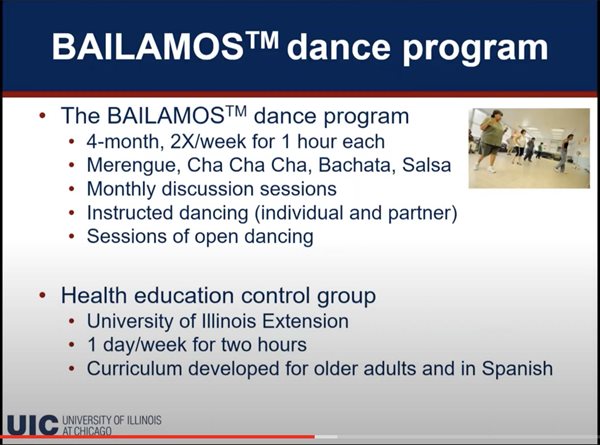According to a 2016 report by researchers at the University of Southern California, U.S. Latinos living with Alzheimer’s disease are projected to increase from 379,000 in 2012 to 1.1 million by 2030 and to 3.5 million by 2060 – a growth of 832 percent. However, experts are also acutely aware Hispanics and Latinos are historically the most underrepresented population in today’s Alzheimer’s research, emphasizing the need for increased efforts to engage U.S. Latinos in clinical research.
 This is what inspired David X. Marquez, PhD, an expert in health disparities within the Latino community, to conduct a study. Dr. Marquez spoke to the Salus University community during a recent DEI Speaks! event about the genesis of his passion project that started with his own personal connection to the disease.
This is what inspired David X. Marquez, PhD, an expert in health disparities within the Latino community, to conduct a study. Dr. Marquez spoke to the Salus University community during a recent DEI Speaks! event about the genesis of his passion project that started with his own personal connection to the disease.
“My father passed away from Alzheimer's about a year and a half ago. I did the work professionally, I have also experienced it through my dad personally, and in general, it's a horrific disease that often takes away who people are,” he said. “You might have a connection with Alzheimer's. If you don't now, unfortunately, you probably will in the near future, because it’s really increasing in its prevalence, and especially amongst Latinos.”
Dr. Marquez is a professor of kinesiology and nutrition and the director of the Exercise Psychology Laboratory at the University of Illinois at Chicago. He is also the lead investigator of a Rush University Medical Center study focused on Alzheimer’s disease risk factors in older Latino adults.
In his talk titled “Importance of Culture in Addressing the Health of Latino/a/xs,” which was hosted by the University’s Office of Diversity, Equity and Inclusion, Dr. Marquez discussed how cultural sensitivity can be one of the best tools in working to remove barriers and disparities in health faced by older Latinos.
Goals of the study set out to not only influence cognition, but also to increase physical activity, which is why Dr. Marquez developed a dance program called BAILAMOS™, a community-based intervention focused on Latin dancing. After learning there was a dearth of dance programs, specifically for older Latino adults in the city, Dr. Marquez enlisted the help of Miguel Mendez, a professional dance instructor in Chicago.
“I brought the science, Miguel brought the dance,” he said. “So, we teamed up and we created this program with the rationale, if you talk to people about exercising, if they do it, they love talking about it. But, if they're like a lot of people, they don't exercise regularly. When you talk to Latinos about dancing, it’s the opposite reaction. It's fun, it's social, it's not boring like getting on a treadmill, and scientifically, we could say it challenges people physically, you get your heart rate elevated, it takes coordination, which also involves your brain, and cognitively needing to remember dance steps, reacting to your partner as your partner is moving.”
Data from his research proved Latin dance to be an effective strategy, blending both health and culture, to engage older members of the community in clinical research and exercise. After all, Alzheimer’s research has consistently linked cognitive benefits to physical activity.
They recruited Spanish-speaking Latinos around age 65 who had low levels of physical activity and assigned them to a program for four months. Some took the dance classes, which met twice a week for an hour, while others enrolled in a health education program, which served as the control group, meeting one day a week for two hours. Both groups also participated in a series of neuropsychological tests in the format of being told a story and then asked to recall it verbatim.
At the end of the study, in terms of how many details each group remembered from the story, the control group stayed the same while the dance group showed significant improvement, recalling more than twice as many details.
Dr. Marquez and his lab colleagues have repeated the study several times, varying the control group activity, while keeping Latin dance central to the physical activity component of the research. Results consistently show the value of the intervention program, which has also received funding from the National Institutes of Health (NIH), and suggest even wider public health implications. But Dr. Marquez attributes much of the study’s success to the culturally attuned activity of Latin dancing as well as the cultural sensitivity of the group’s recruitment efforts.
“Cultural values and belief are a part of people's lives, all aspects of life, and I believe must be considered in working with individuals,” he said. “It’s not groups of people, necessarily it's individuals. In practice, like you all as healthcare providers, and in research, because they help us describe, explain, and sometimes predict, what's going to happen with an individual.”
The next DEI Speaks! event will be hosted online Wednesday, March 2 at 12 p.m., featuring Nydia Han, an investigative reporter and a Sunday morning co-anchor with 6ABC. Han will discuss her work on #ThisIsAmerica (issues of race, discrimination, and bias), aiming to inspire all people to get to know each other’s unique American stories, challenge biases, and act as positive agents of change and unity.